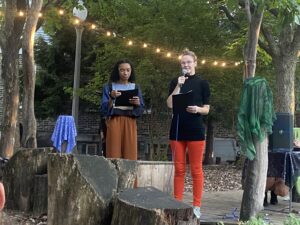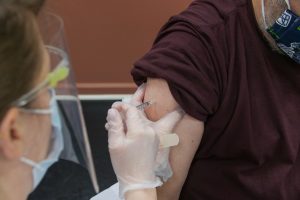After being stonewalled by the Burlington Northern Santa Fe railway company, the EPA will be seeking a warrant from the courts to clean up toxic land on the railway’s property that tested for lead content as high as 23,000 parts per million, the highest level of lead contamination seen in Pilsen yet and more than 57 times the level safe for humans.
The Pilsen Environmental Rights and Reform Organization announced in December of 2012 that the EPA would be conducting a number of tests in Pilsen. The EPA has increased activity in Pilsen after pressure from PERRO and started numerous initiatives to gauge the risk pollution in the community poses for citizens. The efforts have already seen tremendous support from community organizations and members. However, the EPA’s sudden involvement in the issue was not achieved without difficulty, and the city has given little attention to Pilsen’s lead situation up until now.
In March a meeting was held at the Walsh Elementary School between community residents, Ald. Danny Solis (25th), the EPA, the Chicago Department of Health and PERRO to address pollution concerns and present remediation plans to residents.
“We are looking at a number of options to protect the children and families of the neighborhood from any potential contaminants,” said Solis. “Safety is my number one priority and I want to work with all of the stakeholders to ensure that we are doing everything we can to remedy any potential threat.”
After the EPA’s test results identified hazardous amounts of lead in the soils at the Lowenthal Metals site, 947 W. Cullerton St., Solis erected a fence around the plot of land where an old lead and zinc smelter stood in the 1940s. Toxic soils have remained at the site for 70 years, endangering children and pedestrians traveling from the nearby Walsh Elementary School and Growing Station Community Garden.
Still, PERRO initially struggled to achieve correspondence with the Illinois EPA, who according to Jerry Meade-Lucero, a spokesperson for PERRO, knew about the toxic Lowenthal site long before anyone else did.
“The Illinois EPA knew about the site as far back as 2006 but never communicated with us even though they knew about us,” said Meade-Lucero. “For years we didn’t know about it and it escaped our attention all together.”
With all eyes finally on Pilsen, the EPA has embarked on four initiatives in the area and is currently seeking a court order that will allow them to begin emergency remediations at the former Lowenthal site to prevent the possible spread of lead poisoning.
Sally Gordon, driving force behind the Growing Station Community Garden group, has been planting foliage around the empty lot adjacent to the Lowenthal site and picking up trash that might render it an eyesore or pose a danger to children who walk across it. Every day that Gordon works on the lot, she says she puts her life in further danger
“I think this whole strip of land is lead,” said Gordon. “I’m probably going to die of lead poisoning because I’ve been planting stuff here. The so-called weeds actually protect people from lead the taller they are.”
However, it is difficult to know how much lead has been affecting residents, because like the Illinois EPA, the City of Chicago has been negligent in its communication about the effects of lead in the area, if not omissive.
From 1999 to 2011, the City of Chicago compiled a tabulation of elevated blood levels in children ages zero through six in 50 different areas in Chicago. But despite pollution problems in Pilsen and Little Village, neither were represented in the city’s data chart.
Historically, lead has been a huge problem in Chicago communities, and while much of lead’s original potency was found in lead paint, which was banned in 1972, lead concentrations in blood concentrations have remained dangerously high in many Chicago children.

A recent Chicago Reader article indicates that roughly 35 years after the lead paint ban, the University of Illinois at Chicago conducted a study to examine blood levels of third graders from 2003 to 2006. In approximately three-quarters of Chicago’s 464 elementary schools, average student blood levels were high enough to be considered poisonous, according to the Centers for Disease Control and Prevention.
A 2011 Atmospheric Environment article indicates lead contaminated soil is a major source for atmospheric aerosol loadings. The article states resuspension of lead contaminated soil has repercussions for ongoing harmful lead exposures in urban children.
According to Meade-Lucero, one of the [Pilsen] community’s problems is cumulative impact.
“When you have a bunch of polluters in a small area near houses and apartments, that creates a unique problem,” said Mead-Lucero.
The EPA collected soil samples in December of 2012 from an alley behind an active smelting facility that runs east to west between Loomis and Throop streets north of W. Cermak Road with surface soil containing lead concentrations as high as 6,600 ppm and an average of 2,748 ppm.
Soil in the same area six to 24 inches deep contained lead levels as high as 9,300 ppm with an average of 4,736 ppm
According to the EPA, children like the ones attending the Walsh Elementary School near the Lowenthal site are especially at risk for lead because their growing bodies absorb more lead than adults and their brains and nervous systems are more sensitive to its damaging effects.
An Illinois blood lead surveillance report conducted by the Centers for Disease Control and Prevention ranging 1997 to 2008 showed elevated blood levels of lead in Illinois children are improving with a steady one percent annual drop since 2003 when approximately half of children tested had elevated levels of lead in their blood.
Ten percent of children were tested in 2008 and only two percent demonstrated higher blood lead contents, but there is still no CDCP data for children living specifically in the Pilsen or Little Village communities where residents are especially at risk.
According to the EPA, lead can affect almost every organ and system in the body and children six years old and younger are most susceptible. Lead toxicity targets the nervous system and even very low levels can result in permanent brain damage, leading to behavior and learning problems, lower IQ, slowed growth, anemia and hearing problems.
The Walsh Elementary School principal and vice principal were unavailable for comment on the Lowenthal site’s potential impact on their students because they were preoccupied with students every time an attempt to talk was initiated.
Regardless of past neglect, residents are keeping their fingers crossed for a remediated Pilsen and Little Village in the near future, even though apprehension has become a natural response for many.
“I think there’s always a little weariness because it’s taken so long to get these sites resolved, but I feel confident this will be addressed,” said Meade-Lucero. We’re here to keep the pressure and make sure it happens, and I think the pressure is part of the reason we’re making progress.”
The EPA will be collecting soil samples in Pilsen and analyzing them for lead and other metals to determine if lead has been released over the years into the air and settled into neighborhoods.
So far the EPA has requested soil testing authorization from 165 resident homes with 40 approving households, according to Heriberto Leon, the community involvement coordinator for the EPA.
Leon says the EPA will also be implementing a community involvement plan based on resident feedback regarding basic neighborhood concerns.
“We’re gathering information and collecting people’s concerns from the neighborhood to figure out the best way to pass on information to the community,” said Leon. “Categories of concern include health, gardening, child health and spreading information about what we’re doing, what we’re finding, that sort of thing.”
With the recent closure of the Fisk and Crawford coal plants and the remediation imperatives being mandated for the H. Kramer and Co. copper smelting plant, residents are optimistic that environmental advocates like PERRO will be able pressure big players like the state and federal EPA to deliver the remediation needed most.
“I am optimistic about improvement because PERRO will continue to be a watchdog,” said Leila Mendez, a member of PERRO and community resident of Pilsen who has struggled with health consequences facing residents. “We’re watching out for everyone and making sure things are being done the way they should be done.”
With the Lowenthal site’s upcoming EPA overhaul, the question still remains as to what will happen to the Growing Station Community Garden. But Gordon suggests the only thing that matters is that things get cleaned up in the interest of safety for residents.
“We are happy about the cleanup and have adjusted our season to adapt to the safety of our gardeners,” said Gordon. “The EPA have a huge job and have been very accessible. I believe they are attentive and serious about cleaning up the site and are taking every precaution.”
Related articles
- Lead pollution in Pilsen takes new form(chicagotalks.org)




























Be First to Comment